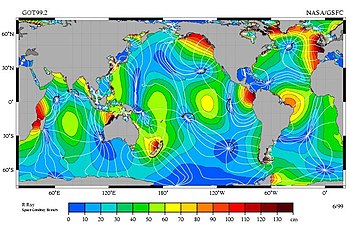added amphidromic system |
Eric Kvaalen (talk | contribs) Made lists of amphidromic points, based on the figure. |
||
| Line 1: | Line 1: | ||
An '''amphidromic point''' is a point within a tidal system where the [[tidal range]] is almost zero. |
An '''amphidromic point''' is a point within a tidal system where the [[tidal range]] is almost zero. |
||
[[Image:M2 tidal constituent.jpg|thumb|right|350px|The ''M''<sub>2</sub> tidal constituent the amplitude indicated by color. The white lines are cotidal |
[[Image:M2 tidal constituent.jpg|thumb|right|350px|The ''M''<sub>2</sub> tidal constituent, the amplitude indicated by color. The white lines are cotidal lines spaced at phase intervals of 30° (a bit over 1 hr). |
||
<ref> Picture credit: R. Ray, [http://svs.gsfc.nasa.gov/stories/topex/tides.html TOPEX/Poseidon: Revealing Hidden Tidal Energy] [[GSFC]],[[NASA]]. Redistribute with credit to R. Ray, as well as NASA-[[GSFC]], NASA-[[JPL]], Scientific Visualization Studio, and Television Production NASA-TV/GSFC</ref>]] |
<ref> Picture credit: R. Ray, [http://svs.gsfc.nasa.gov/stories/topex/tides.html TOPEX/Poseidon: Revealing Hidden Tidal Energy] [[GSFC]],[[NASA]]. Redistribute with credit to R. Ray, as well as NASA-[[GSFC]], NASA-[[JPL]], Scientific Visualization Studio, and Television Production NASA-TV/GSFC</ref>]] |
||
Amphidromic points occur because of the [[coriolis effect]] and [[interference]] within [[oceanic basin]]s and [[Headlands and bays|bay]]s creating a wave pattern — called an '''amphidromic system''' — which rotates around the amphidromic point. At the amphidromic point, there is almost no vertical movement. There can be tidal currents as the water levels on either side of the amphidromic point are not the same. |
Amphidromic points occur because of the [[coriolis effect]] and [[interference]] within [[oceanic basin]]s and [[Headlands and bays|bay]]s creating a wave pattern — called an '''amphidromic system''' — which rotates around the amphidromic point. At the amphidromic point, there is almost no vertical movement. There can be tidal currents as the water levels on either side of the amphidromic point are not the same. |
||
Based on the accompanying figure, the set of clockwise amphidromic points includes: |
|||
Amphidromic points occur at [[Tahiti]], off the coast of [[Newfoundland (island)|Newfoundland]], near the [[South Shetlands]], midway between [[Rio de Janeiro]] and [[Angola]], at three points in the [[North Sea]] and in general at several more points in the [[Pacific Ocean]], [[Atlantic Ocean]] and [[Indian Ocean]]. The island of [[Madagascar]] is an amphidromic point, as is [[New Zealand]]. |
|||
* north of the [[Seychelles]] |
|||
* near [[Enderby Land]] |
|||
* off [[Perth]] |
|||
* east of [[New Guinea]] |
|||
* south of [[Easter Island]] |
|||
* west of the [[Galapagos Islands]] |
|||
* north of [[Queen Maud Land]] |
|||
Anti-clockwise amphidromic points include: |
|||
| ⚫ | ''M''<sub>2</sub> is the largest (semidiurnal) tidal constituent. The amplitude is half of the full tidal range. Cotidal points means they reach high tide at the same time and low tide at the same time |
||
* near [[Sri Lanka]] |
|||
* north of [[New Guinea]] |
|||
* at [[Tahiti]] |
|||
* between [[Mexico]] and [[Hawaii]] |
|||
* near the [[Leeward Islands]] |
|||
* east of [[Newfoundland]] |
|||
* midway between [[Rio de Janeiro]] and [[Angola]] |
|||
* east of [[Iceland]] |
|||
The islands of [[Madagascar]] and [[New Zealand]] are amphidromic points in the sense that the tide goes around them (counterclockwise in both cases) in about 12 and a half hours, but the amplitudes of the tides on their coasts is in some places large. |
|||
| ⚫ | ''M''<sub>2</sub> is the largest (semidiurnal) tidal constituent. The amplitude is half of the full tidal range. Cotidal points means they reach high tide at the same time and low tide at the same time. In the accompanying figure, the low tide lags or leads by 1 hr 2 min from its neighboring lines. Where the lines meet are [[amphidromic point|amphidromes]] and the tide rotates around them; for example: along the Chilean coast, and from southern Mexico to Peru the tide propagates southward, while from Baja California to Alaska the tide propagates northward. |
||
==References and Notes== |
==References and Notes== |
||
<references/> |
<references/> |
||
Revision as of 17:04, 21 October 2008
An amphidromic point is a point within a tidal system where the tidal range is almost zero.

Amphidromic points occur because of the coriolis effect and interference within oceanic basins and bays creating a wave pattern — called an amphidromic system — which rotates around the amphidromic point. At the amphidromic point, there is almost no vertical movement. There can be tidal currents as the water levels on either side of the amphidromic point are not the same.
Based on the accompanying figure, the set of clockwise amphidromic points includes:
- north of the Seychelles
- near Enderby Land
- off Perth
- east of New Guinea
- south of Easter Island
- west of the Galapagos Islands
- north of Queen Maud Land
Anti-clockwise amphidromic points include:
- near Sri Lanka
- north of New Guinea
- at Tahiti
- between Mexico and Hawaii
- near the Leeward Islands
- east of Newfoundland
- midway between Rio de Janeiro and Angola
- east of Iceland
The islands of Madagascar and New Zealand are amphidromic points in the sense that the tide goes around them (counterclockwise in both cases) in about 12 and a half hours, but the amplitudes of the tides on their coasts is in some places large.
M2 is the largest (semidiurnal) tidal constituent. The amplitude is half of the full tidal range. Cotidal points means they reach high tide at the same time and low tide at the same time. In the accompanying figure, the low tide lags or leads by 1 hr 2 min from its neighboring lines. Where the lines meet are amphidromes and the tide rotates around them; for example: along the Chilean coast, and from southern Mexico to Peru the tide propagates southward, while from Baja California to Alaska the tide propagates northward.